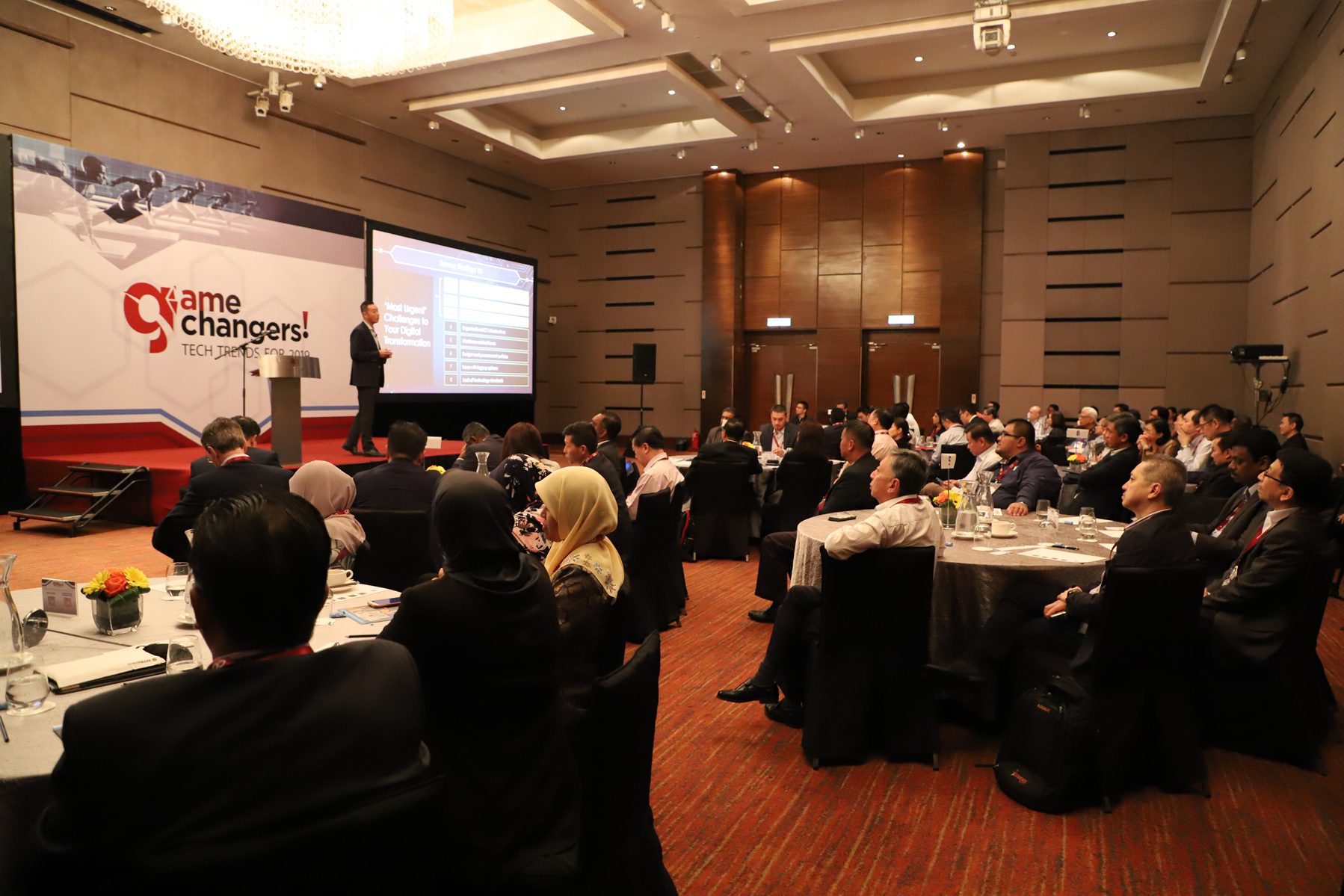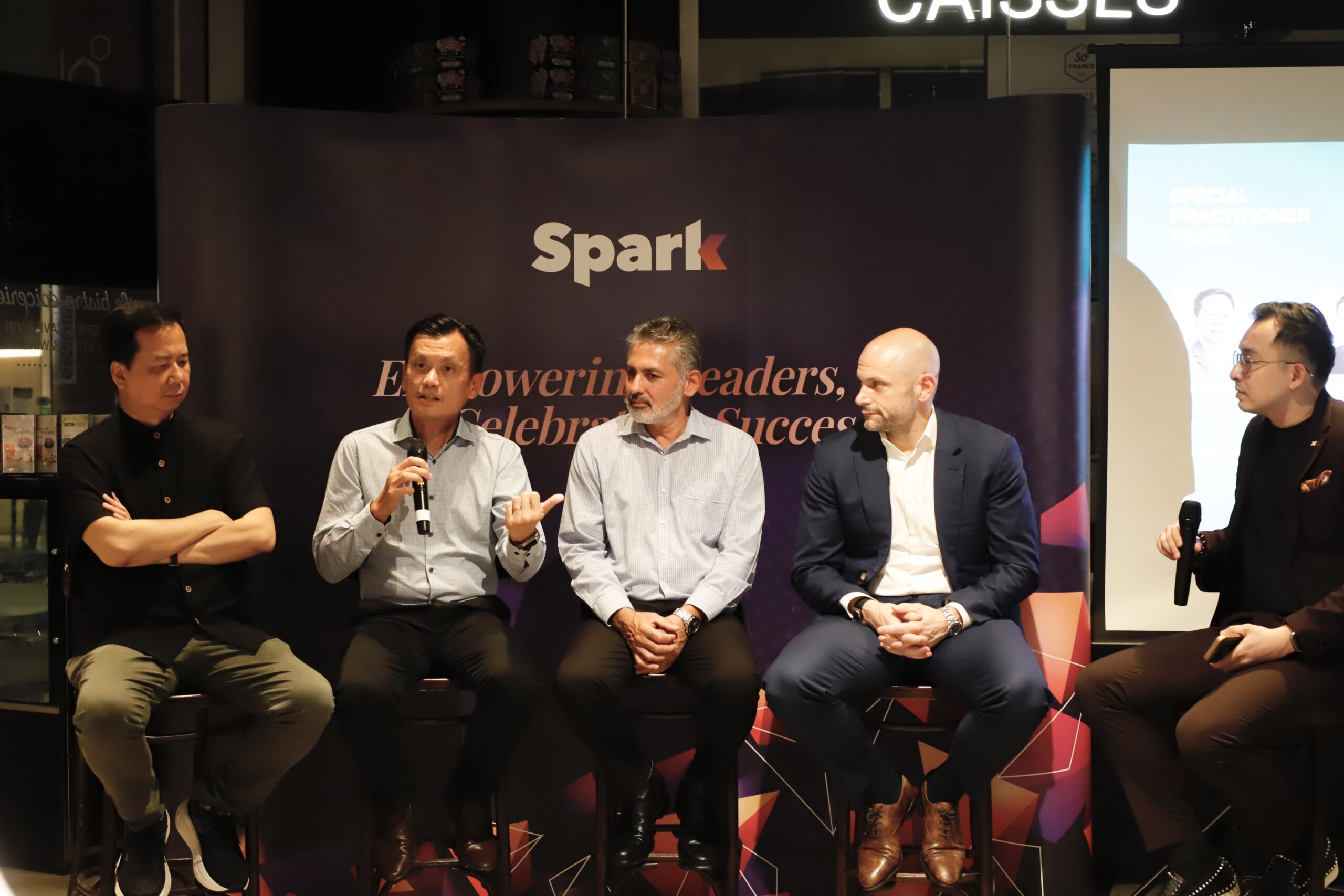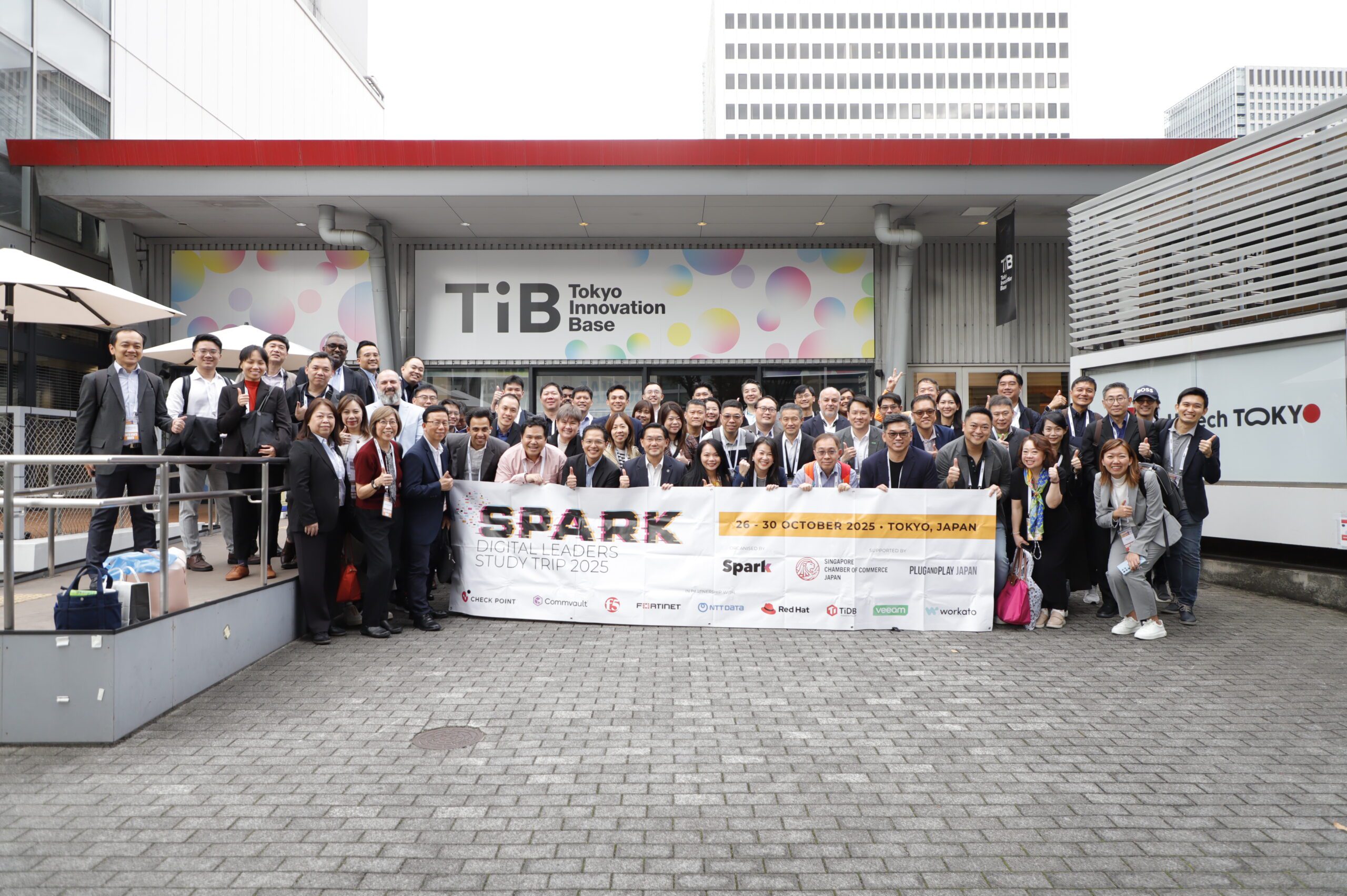[vc_row][vc_column][vc_column_text]Sustainable digital transformation and continual innovation were themes discussed at the Malaysian edition of GameChangers held in Kuala Lumpur on 21 February 2019. GameChangers, the CIO Academy Asia (CIOAA) technology trends outlook forum series, brought together leaders from government, enterprises and technology companies to deliberate on digital imperatives for the year ahead.
A major talking point at the forum was key findings from CIOAA’s Tech Trends and Priorities Survey. Malaysian CIOs and Technology Leaders had participated in the survey conducted at the beginning of this year. It revealed that Data Analytics and Artificial Intelligence was expected to have the biggest impact on Malaysian businesses in the next two years. Cybersecurity was also a key focus for 2019-2020. Other useful indicators covered in the survey findings which would serve as a beacon for tech leaders in Malaysia were also explored. In addition, the forum featured CIOAA’s framework on the key digital competencies which drives digital transformation, i.e. Agility; Cyber-resilience; Innovation & Design; Data Analytics (ACID).
Anchoring the conversations around the survey findings and the ACID framework, industry leaders, technology experts and technology practitioners took to the stage to share best practices, how emerging tech trends influenced the way we work, live and play – and the importance for organisations and leaders to ‘think big, start small, and act fast’ to stay competitive.[/vc_column_text][/vc_column][/vc_row][vc_row][vc_column][vc_column_text]
Technology as the platform for continual business reinvention
The challenge of maintaining continual digital transformation in an ever-changing business environment was the theme of the Malaysian edition of GameChangers: Tech Trends for 2019. The forum brought together over 60 senior IT practitioners and industry experts to discuss the benefits of a digital-driven strategy in sustaining enterprise growth in a fast-evolving economy. Organised by CIO Academy Asia (CIOAA), the forum was held at DoubleTree by Hilton Kuala Lumpur on 21 February 2019.
“Technology leaders have to go beyond digital transformation and develop digital sustainability,” said P. Ramakrishna (Rama), Chief Executive Officer, CIO Academy Asia in his welcome address. “Digital transformation is not a one-off exercise; it is a never-ending journey, and leaders have to create an environment where an organisation can continually adapt and develop the digital talent to spark innovation and renewal.”
Furthermore, the role of CIOs was transitioning away from managing technology to managing business impact. “CIOs are no longer measured by traditional means. The change in mindset starts at the top,” asserted Andy Tan, Chief Digital Officer, Human Resource Development Fund Berhad and Deputy Chair, PIKOM CIO Chapter in his opening remarks. “We have to change ourselves and our skillsets to be successful in changing our approach dramatically.”
These observations were borne out in the findings of the Tech Trends and Priorities Survey Malaysia 2019 which was conducted by CIOAA earlier this year. Technology leaders across 15 industry verticals in Malaysia were asked to share their insights on game-changing technology trends which would have a big impact on their businesses.

CIOAA had identified four leadership competencies that were critical for success in digital transformation – Agility, Cyber-Resilience, Innovation & Design, and Data Analytics. These competencies form the ACID framework. “Our respondents in Malaysia ranked Agility ahead of the other three core digital leadership competencies as most essential to the success of their digital transformation efforts,” announced Koh Kok Tian, Deputy Chief Executive Officer, CIO Academy Asia in sharing the results of the survey. “Technology is disruptive. Thus, agility and the ability to respond to change quickly are seen as key components of success.”
Cyber-Resilience came in a close second. “Cybersecurity and risk management continues to be a critical area of focus for all respondents who expect to see more implementation activity (51 percent) through the next couple of years,” said Koh.
Data Analytics featured prominently as the primary area of concern for organisations seeking to increasingly derive value from their ever-growing information stores. It ranked highest (cited along with Artificial Intelligence by 78 percent of respondents) among all technology trends expected to have the biggest impact on their business in the next one to two years. Consequently, leaders expected to invest most in data analytics in the next few years.
Meanwhile, the most urgent challenges were seen to be budget constraints, internal resistance to changes, and differing agendas within an organisation. “Issues with legacy systems were also prevalent amongst respondents in Malaysia,” added Koh. “Weak points in legacy systems are at odds with the importance of data analytics. It is difficult to embrace customer-centric requirements without the capacity to obtain and use data effectively.”[/vc_column_text][/vc_column][/vc_row][vc_row content_placement=”middle” bg_type=”bg_color” bg_override=”1″ bg_color_value=”#568ebf”][vc_column][vc_separator color=”custom” accent_color=”#568ebf”][vc_column_text]
Key takeaways
Agility is seen as the most essential component in successful digital transformation.
Investment in Data Analytics expected to increase because of its importance to businesses.
Modernising legacy systems is seen as a major challenge.
[/vc_column_text][/vc_column][/vc_row][vc_row][vc_column][vc_separator color=”white” border_width=”10″][vc_column_text]
Riding the Digital Wave
In her keynote address on digital transformation’s macro-economic impact, Dato’ Ng Wan Peng, Chief Operating Officer, Malaysia Digital Economy Corporation (MDEC) reminded participants that technology’s potency depended on how it was used
“We cannot stay away from disruptive technology. However, not all technology will work for your business. You need to know which technology will help your business grow,” she said. “It is only when you can apply your understanding of technology to the benefit of your business that it becomes useful.”
Similarly, data was only your most valuable asset if you used it effectively. “Data is not just about collecting and storing numbers and customer details, but about creating value for your business, improving customer interaction and creating future growth,” said Dato’ Ng.[/vc_column_text][/vc_column][/vc_row][vc_row content_placement=”middle” bg_type=”bg_color” bg_override=”1″ bg_color_value=”#568ebf”][vc_column][vc_separator color=”custom” accent_color=”#568ebf”][vc_column_text]
Key takeaways
- Digital is not only a supply-side technology; it influences a country’s Gross Domestic Product (GDP).
- Not all types of technology are suited to your business.
- Focus not just on the now, but look to the future.
[/vc_column_text][/vc_column][/vc_row][vc_row][vc_column][vc_separator color=”white” border_width=”10″][vc_column_text]
Tap into democratised technologies
In the era of the Fourth Industrial Revolution, the power had shifted from companies to consumers. On the supply side, the balance of power had also moved towards individuals and small teams within companies.

“These shifts highlight the need for flexibility and speed in meeting customer expectations,” stated Dr Dzahar Mansor, National Technology Officer, Microsoft Malaysia. “In the modern business cycle, small companies and start-ups create massive market impact as they have the advantage of being agile when engaging customers and in reacting to changing economic cycles.”
He continued, “The democratisation of technology platforms such as mobility, cloud and big data, makes them affordable for small enterprises. Weaving available underlying technologies into a single platform enables enterprises to innovate and experiment with new ideas while tapping on today’s success. Once an enterprise hits on a successful idea, it can then ‘blitzscale’ while trying out further fresh ideas for the future. Digital transformation is a continuous cycle to reinvent your business.”
This called for a new approach to business thinking. “Unlocking digital potential calls for changes in mindset, culture and approach. Train your people to challenge the status quo, encourage them to be more open in sharing information and to collaborate, empower them to explore new ideas. Back disruptive innovations or moonshots, and leverage on successful innovations to fund your next phase of growth,” advised Dr Dzahar.[/vc_column_text][/vc_column][/vc_row][vc_row content_placement=”middle” bg_type=”bg_color” bg_override=”1″ bg_color_value=”#568ebf”][vc_column][vc_separator color=”custom” accent_color=”#568ebf”][vc_column_text]
Key takeaways
Break down the silos. Give impetus to building an integrated platform with different underlying technologies which work together to provide agility.
Break the culture of the old. Re-think approaches with an open mindset which looks toward the future.
Break down your business issues by asking sharp questions and honing in on the problem.
[/vc_column_text][/vc_column][/vc_row][vc_row][vc_column][vc_separator color=”white” border_width=”10″][vc_column_text]
Be aware of lurking danger
“Risk is like an iceberg. What you see is just surface risk and this is the tip of the iceberg,” warned author, columnist and tech evangelist Raju Chellam, Senior Advisor, CIO Academy Asia. “Beneath the water lies the Deep Web and the Dark Web, and it is here that true danger lurks. The Deep Web refers to the hidden, non-illegal web. Within the Dark Web, however, lies activities which are most definitely illegal. Many organisations pay too little attention to the Deep and Dark Web.”

“Identity theft is a major attraction to hackers. By gaining access to key identities, hackers have the potential to compromise entire organisations. Key identities include those of C-level executives as well as system and network administrators. Ensure that these identities are sufficiently protected through measures such as two-factor authentication or use of biometrics,” advised Chellam.
Cybersecurity was seen as the second most essential component to successful digital transformation according to Malaysian respondents to the CIOAA survey. The biggest cost from a cyberattack was loss of productivity. However, total losses were difficult to measure as it also involved loss of reputation which may end up being higher in the long run compared to the actual dollar loss.[/vc_column_text][/vc_column][/vc_row][vc_row content_placement=”middle” bg_type=”bg_color” bg_override=”1″ bg_color_value=”#568ebf”][vc_column][vc_separator color=”custom” accent_color=”#568ebf”][vc_column_text]
Key takeaways
Actively defend your organisation. Anticipate attacks, protect critical identities, test your systems and do digital forensics.
Pull in the experts. Siphon off your security to security specialists with the relevant skills and experience.
Ensure that the deep web and dark web protection pillars are built into your Cybersecurity.
[/vc_column_text][/vc_column][/vc_row][vc_row][vc_column][vc_separator color=”white” border_width=”10″][vc_column_text]
Panel discussion: Technology trends for 2019
Rounding up the morning session were three panel discussions. The first panel took a closer look at the trends which had been identified as most likely to have a significant impact in the near future.
In the area of data analytics, Duncan Williamson, Managing Director, SAP Malaysia believed that the challenge was in identifying and integrating data from different sources which would add value to the enterprise. “The ability to combine both operational data and customer experience data is crucial. A lot of data is being generated and collected internally and externally, but these need to be connected. If people cannot understand or use the data to give them insights, it is of no use to them and they will not use it,” he said. “Therefore, it is critical to invest the time and effort to make it consumable.”
Paul Serrano, Chief Evangelist, APJ, Nutanix agreed that making technology transparent to users was an advantage. “Build technology directly into your work process and put the intelligence into the tools and systems. The cloud gives enterprises the ability to pull together data from different areas of business for interpretation and adaption in a single location. It simplifies the analysis process and makes consumable information more easily and quickly available to users across the enterprise. This agility allows the enterprise to react, deploy and scale faster,” he said. [/vc_column_text][/vc_column][/vc_row][vc_row content_placement=”middle” bg_type=”bg_color” bg_override=”1″ bg_color_value=”#568ebf”][vc_column][vc_separator color=”custom” accent_color=”#568ebf”][vc_column_text]
[/vc_column_text][/vc_column][/vc_row][vc_row content_placement=”middle” bg_type=”bg_color” bg_override=”1″ bg_color_value=”#568ebf”][vc_column][vc_separator color=”custom” accent_color=”#568ebf”][vc_column_text]
Key takeaways
Generate consumable integrated data which will provide insights.
Data is only useful if it can be used to solve business problems.
Build intelligence into your tools to make it easier for users.
[/vc_column_text][/vc_column][/vc_row][vc_row][vc_column][vc_separator color=”white” border_width=”10″][vc_column_text]
Panel Discussion: Fighting from the trenches
In the second panel discussion, industry leaders and practitioners provided insights on leveraging new technologies for competitive advantage.
“Digital transformation allowed us to pursue what would give us a competitive advantage,” stated Hood Abu Bakar, Group CIO, MISC Berhad. “Our forte is in energy-related maritime solutions and services, and that is what we want to focus on. Data centres are not our core competency, so we outsource it. We choose to outsource our systems and records to minimise worrying about issues such as storage or downtime. We use cloud for functions which will benefit us. Operationally, it makes sense to use technology which will ultimately provide us with a global advantage.”
Alain Boey, Chief Transformation Officer, Media Prima Berhad noted that data analytics was a major disruption in his industry. He said, “Consumer consumption is very different today. Malaysians are increasingly getting their information from their mobile devices. We need to harness our data from internally-generated data as well as from social media sources and applications. We use third-party tools to pull social media data to understand what our consumer wants. This information enables us to customise and target advertising more effectively, for example.”
“Speaking from the manufacturing perspective, speed is crucial and so is accessibility. With our well-designed, flexible platform, we can act quickly to change as the market changes. This makes us attractive to start-ups,” said Lee See Nee, Vice President, IT Operations and Global Applications Support, Flex.
He added, “With that same platform, we have access to real-time data – machine data pulled from the production floor is massaged immediately and that information is available to people who need it straight away. However, the data is only useful if we can get it on an end-to-end basis. This means working with our suppliers along the entire supply chain to ensure we have all such data.”
 [/vc_column_text][/vc_column][/vc_row][vc_row content_placement=”middle” bg_type=”bg_color” bg_override=”1″ bg_color_value=”#568ebf”][vc_column][vc_separator color=”custom” accent_color=”#568ebf”][vc_column_text]
[/vc_column_text][/vc_column][/vc_row][vc_row content_placement=”middle” bg_type=”bg_color” bg_override=”1″ bg_color_value=”#568ebf”][vc_column][vc_separator color=”custom” accent_color=”#568ebf”][vc_column_text]
Key takeaways
Adopt a digital strategy which will give you a competitive advantage in your industry.
Market changes call for different business models and approaches.
A flexible platform offers more than one advantage – it serves all parts of an organisation and throws up new business opportunities.
[/vc_column_text][/vc_column][/vc_row][vc_row][vc_column][vc_separator color=”white” border_width=”10″][vc_column_text]
Panel Discussion: Fostering Innovation, Driving Agility
The final panel discussion focused on innovation and the changing mindset required for enterprises to thrive in the digital economy.
“Innovation in the business model is as important as innovation in technology,” said Gopi Ganesalingam, Vice President, Enterprise Development, MDEC. “Technology and innovation may go hand-in-hand, but it is not a business model. Today’s business model may not be relevant in ten years and has to be constantly re-invented.” He continued, “Furthermore, digital transformation has to start from the top. The role of leaders in stimulating innovation and change is crucial. Changes in mindset will not cascade down unless it is actively adopted by leaders themselves.”
Ramesh Narayanaswamy, Group CTO, CIMB Group Holdings agreed that the first wave of digital transformation had to be top-driven. However, the second and third waves could originate from different levels within the organisation. “The organisation has to buy in to this approach and set up the mechanisms to run with fresh ideas and focus on developing such capabilities. This includes engaging educational facilities, and building an ecosystem to develop local IT talent,” he added.
An effective way of developing such an eco-system was put forward by Mikael Tan, Chief Operating Officer, Sapura Advanced Systems. “Set up small teams made up of people of different skills and area of specialisation. Get them to think up some new ideas within a 16-week timeframe, for example. Teams with the top three ideas will get funding to put their ideas to work,” said Tan. “This will get your employees to start thinking like start-ups and help them develop the skillsets your company needs.”
Dr Sekar Jaganathan, Digital Strategy Director, Kenanga Investment Bank warned of the danger of associating innovation too closely with technology. “Business people should be driving innovation. Innovation is not just about enhancing your product; it is about enhancing your customer experience and delivery. Technology can then be used to fulfil that vision. Successful new companies did not set out to disrupt, but were formed to fill gaps in servicing customers which traditional companies were not addressing,” he said.
 [/vc_column_text][/vc_column][/vc_row][vc_row content_placement=”middle” bg_type=”bg_color” bg_override=”1″ bg_color_value=”#568ebf”][vc_column][vc_separator color=”custom” accent_color=”#568ebf”][vc_column_text]
[/vc_column_text][/vc_column][/vc_row][vc_row content_placement=”middle” bg_type=”bg_color” bg_override=”1″ bg_color_value=”#568ebf”][vc_column][vc_separator color=”custom” accent_color=”#568ebf”][vc_column_text]
Key takeaways
Digital transformation needs to be top-driven to be effective.
Innovation goes beyond technology; it encompasses business models, customer experiences and more.
Build an ecosystem which encourages your people to think like start-ups.
[/vc_column_text][/vc_column][/vc_row][vc_row][vc_column][vc_separator color=”white” border_width=”10″][vc_column_text]
Practices in Innovation
 The afternoon session of the forum continued on with the theme of innovation. Paul Whiten, DevOps Business Development Manager – APAC, Red Hat argued that DevOps activated agility and innovation in an organisation. He stated, “Fundamentally DevOps is the philosophy of IT delivering value to the business faster. This calls for a culture of innovation which enables continual experimentation and learning. Push the boundaries, get rid of the fear of failure. When you do fail, rewind and get back to the start. Learn from the failure and be blameless.”
The afternoon session of the forum continued on with the theme of innovation. Paul Whiten, DevOps Business Development Manager – APAC, Red Hat argued that DevOps activated agility and innovation in an organisation. He stated, “Fundamentally DevOps is the philosophy of IT delivering value to the business faster. This calls for a culture of innovation which enables continual experimentation and learning. Push the boundaries, get rid of the fear of failure. When you do fail, rewind and get back to the start. Learn from the failure and be blameless.”
This theme was taken up by Professor Kevyn Yong, Associate Dean for Corporate Programs, ESSEC Asia Pacific in his innovation workshop which provided a different perspective on innovation through design thinking. “No matter how crazy an idea, it comes from something we know. Give such ideas further thought, explore it, play with it and defer judgement. It does not matter if these are wild ideas. For all you know, your team may be able to refine this wild idea and build something from it,” he said.
The ability to innovate is dependent not only on an open culture of learning; it is equally dependent on a modern platform which can support putting ideas into practice. “Infrastructure plays a part. Weaknesses in legacy systems have to be addressed if enterprises want to optimise opportunities. The modern cloud provides the means for innovation in a secure, agile environment,” pointed out Christopher Lee, Business Group Lead, Cloud & Enterprise, Microsoft Malaysia.[/vc_column_text][/vc_column][/vc_row][vc_row content_placement=”middle” bg_type=”bg_color” bg_override=”1″ bg_color_value=”#568ebf”][vc_column][vc_separator color=”custom” accent_color=”#568ebf”][vc_column_text]
Key takeaways
Innovation flourishes in an environment which does not punish failure.
Experimentation is a major component of successful innovation.
Cloud is a flexible platform which supports experiments with the ability to scale quickly.
[/vc_column_text][/vc_column][/vc_row][vc_row][vc_column][vc_separator color=”white” border_width=”10″][vc_column_text]
The roadmap to transformation
 Digital transformation does not happen in a bubble – the business cycle does not stop while an enterprise re-invented itself. In the conflict between vision and reality, business leaders were likely to take a pragmatic approach to digital transformation. With costs and complexity major factors of consideration, there was a need to marry the old to the new to create continuous invention. This thinking applied to infrastructure as well. That is why Tech Evangelist and Transformational Leader Martin Mackay believed a bi-model IT strategy made more sense for some organisations.
Digital transformation does not happen in a bubble – the business cycle does not stop while an enterprise re-invented itself. In the conflict between vision and reality, business leaders were likely to take a pragmatic approach to digital transformation. With costs and complexity major factors of consideration, there was a need to marry the old to the new to create continuous invention. This thinking applied to infrastructure as well. That is why Tech Evangelist and Transformational Leader Martin Mackay believed a bi-model IT strategy made more sense for some organisations.
“Most organisations will continue to run the mainframe as it is high-performing and stable. Its benefits cannot be disregarded. Yet cloud too has its own advantages. Thus, these organisations will opt for a hybrid environment with an innovative approach to running mainframes as an integrated and agile platform,” he said.
Doing digital transformation well required a strategy with clear corporate goals. “Currently, the business priorities of most organisations do not align to key attributes of the digital economy. Therefore, there is a need to digitise your entire business strategy,” said Mackay. “Re-think the critical role and impact IT has on driving better customer experience. Think of how to build a culture which prizes innovation, continuous reinvention and staying relevant to a whole new generation.”
 Digital transformation meant different things to different people. It could be seen in terms of business-model transformation, customer and user experience transformation, or business operations transformation. “However, the most important thing to remember with digital transformation is to never lose sight of your customers,” emphasised Mohan Mirwani, Senior Advisor, CIO Academy Asia. “Ensure that your strategy helps you enhance your relationship and understanding of your customer while providing your company with a value proposition business model.”
Digital transformation meant different things to different people. It could be seen in terms of business-model transformation, customer and user experience transformation, or business operations transformation. “However, the most important thing to remember with digital transformation is to never lose sight of your customers,” emphasised Mohan Mirwani, Senior Advisor, CIO Academy Asia. “Ensure that your strategy helps you enhance your relationship and understanding of your customer while providing your company with a value proposition business model.”
Besides a coherent strategy, digital transformation required strong execution. Drawing on the Digital Maturity Matrix, he advised organisations to start by understanding their own digital maturity and recognising their own strengths and weaknesses. Secondly, they should choose the digital journey which would work for their particular organisation and align with their business goals. Finally, they had to determine how this digital strategy could sustain their business into the future.
Strong leadership was required to drive changes in mindset and workspace. “Without leadership, there is no investment in digital transformation. The initiatives to change the culture and mindset of an organisation has to start with leaders. Without their active support, an organisation is unable to develop capabilities and innovate,” concluded Mirwani.[/vc_column_text][/vc_column][/vc_row][vc_row content_placement=”middle” bg_type=”bg_color” bg_override=”1″ bg_color_value=”#568ebf”][vc_column][vc_separator color=”custom” accent_color=”#568ebf”][vc_column_text]
Key takeaways
Digital transformation does not exist in a vacuum. Be realistic, be practical, be visionary.
Make digital strategy your business strategy and vice versa
Never lose sight of your customers.
[/vc_column_text][/vc_column][/vc_row][vc_row][vc_column][vc_separator color=”white” border_width=”10″][vc_column_text]In his closing remarks, Rama quoted a recent report by Korn Ferry Institute on Digital Leadership in Asia Pacific which explores the central role of leaders (in eight APAC countries) in the digital sustainability journey, setting out the traits, competencies and drivers necessary to becoming a great digital leader.
Enterprise agility is about market relevance, innovation and confidence, not hierarchy or control. That’s specially true of Malaysia. “Malaysian leaders should build on their innate confidence to expand their leadership capacity,” the Korn-Ferry study reports. “Currently, their strong preference for structure suggests the confidence of Malaysian leaders is restricted to operating in process-driven environments with a high degree of certainty. Leaders will need to find ways to unlock their confidence in more ambiguous situations to enable them to become more adaptable, curious, and take more risks in the face of uncertainty.”[/vc_column_text][/vc_column][/vc_row]







